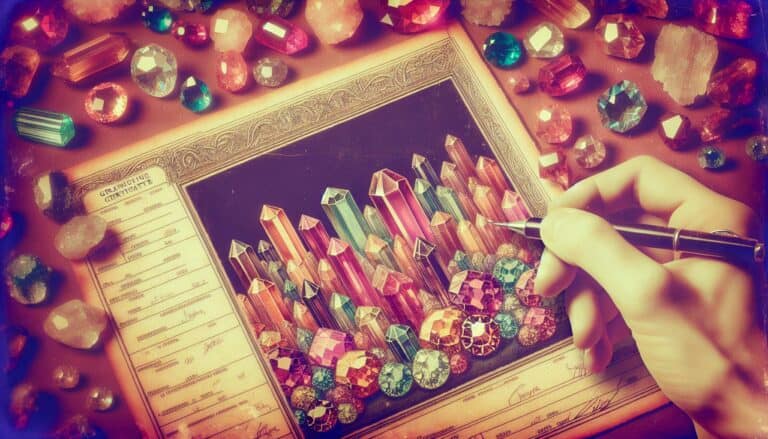Discovering how to identify peridot can be as thrilling as unearthing a hidden gem.
This vibrant green stone, a favorite among jewelers and collectors, has unique characteristics that set it apart from other gems. You’re about to learn the key features that make peridot unmistakable.
Whether you’re a budding gemologist or simply have a passion for precious stones, knowing how to spot a genuine peridot is essential. With its rich, olive-green hue and glassy luster, peridot has a sparkle that’s hard to miss.
Stay tuned as you unlock the secrets to recognizing this august birthstone with ease.
To identify genuine peridot, observe its olive-green to yellowish-green hue and glassy luster. Perform a white streak test, check for weak magnetic reaction, and verify its hardness on the Mohs scale (6.5-7). Genuine peridot exhibits low birefringence, is transparent to translucent, singly refractive, and has a specific gravity of 3.34-3.37.
How to Identify peridot Through Testing
Visual Inspection
Engage your eyes first. Look for the distinct olive-green to yellowish-green hue that peridot is famous for. Its glassy luster should catch the light, differentiating it from duller stones. Flaws within the gem, known as inclusions, are common but don’t detract from peridot’s value. Pay attention to these characteristics; they’re your first clues.
The Streak Test
The streak test is a handy tool for identification. To perform this, drag your peridot across an unglazed porcelain tile and examine the color of the streak left behind. Peridot typically leaves a colorless streak, allowing you to differentiate it from other minerals that may leave a colored streak.
Magnet Test
Peridot, comprising iron, can show a weak magnetic reaction. Place a strong magnet near your stone and look for a slight pull. It’s subtle but can further affirm the presence of iron in the gemstone.
Hardness Test
The Mohs scale of hardness evaluates a mineral’s scratch resistance. Peridot ranks at about 6.5 to 7 on this scale. Try to scratch your specimen with a common object of known hardness, like a steel file, to assess its durability. However, keep in mind that testing on your gem should be minimal to avoid damage.
Birefringence Test
Peridot exhibits double refraction. When viewed under a magnifying glass, you might see two distinct sets of facet edges. This birefringence isn’t found in all green gemstones, making it a reliable identifying factor.
Checking The Diaphaneity
This gemstone has a trait of being transparent to translucent. Hold your peridot up to a light source and observe how light passes through it. This can provide insight into the quality and authenticity of your peridot.
Single or Double Refraction
Understanding refraction in gemstones can be telling. Peridot is doubly refractive, meaning light splits into two rays as it passes through the stone. This characteristic can be observed with a dichroscope or even by looking closely at the way light splits inside the stone.
Refractive Index Test
Professional gemologists often use refractometers to measure the refractive index (RI). The RI for peridot ranges from 1.654 to 1.690. Values within this range bolster the identification of your gem as peridot.
Finding The Specific Gravity
Specific gravity is the ratio of the density of a substance to the density of water. For peridot, it typically falls between 3.34 and 3.37. Weighing the gem and utilizing hydrostatic methods help determine this number, providing another confirmation of your stone’s identity.
Identifying Peridots in the Field
When you’re out in the field, recognizing potential peridot specimens involves examining the surrounding rocks and soil. Peridot is often found in volcanic regions within igneous rocks. Look for green crystals that can be prismatic and transparent, which might protrude from the host rock.
Recognizing Potential Peridot Rocks
Inspect for rocks that have cavities or vugs since peridot crystals can grow within these spaces. Characteristic green grains or crystals embedded in basalt or gabbro are strong indications of peridot presence. Knowing the typical geological setting will guide you toward the areas most likely to yield peridot.
Physical Characteristics of peridots

When looking to identify peridot, you’ll notice distinct physical characteristics that set it apart from other gemstones. Peridot is known for its olive to lime green hues, which result from the presence of iron. Unlike other green gems, peridot’s green does not change color under artificial light, which can be a key identifier.
The gem’s transparency is another distinguishing feature. Peridots are transparent to translucent, allowing light to pass through, which gives them their signature sparkle. You should also observe the luster, which in the case of peridot is vitreous, resembling the gleam of glass.
In terms of structure, peridot crystals form in an orthorhombic system. They often have a distinctive, round crystal habit with a somewhat greasy luster and conchoidal to uneven fracture. When examining the stone, look for this crystal formation as a strong indicator of peridot.
For those familiar with the Mohs scale of hardness, peridot falls at a 6.5 to 7, which suggests it can resist scratches from softer materials. It’s softer than quartz but harder than gold. You can perform a simple scratch test to determine its relative hardness.
Pay attention to the stone’s cleavage; peridot has poor to distinct cleavage, which means it’s less likely to show clean breaks along specific planes. This characteristic can be observed upon careful visual examination or under magnification.
By examining these physical characteristics alongside the tests mentioned earlier, you’re well-equipped to accurately identify a peridot. Remember, each gemstone carries its own set of unique properties that when studied closely, reveal its true nature.
How Are peridot Formed?
Peridot, with its signature hue, is born from extreme conditions deep within the Earth. Mantle rocks from over 20 miles beneath the surface are the birthplace of this vibrant gem. It’s a mineral called olivine, and it crystallizes from magma in igneous rocks. The process isn’t hasty; it takes centuries, growing slowly as the molten rock cools.
The unique green stone also has a cosmic connection; some peridot crystals form in pallasite meteorites, remnants of space collisions that deliver these gems from the stars to your hands. This extraterrestrial origin makes peridot one of few gemstones known to exist beyond our planet.
In volcanic regions, the explosive activity can catapult peridot-bearing rocks to the surface. Once above ground, erosion and tectonic shifts may expose these gems. Your search for peridot in the field can benefit from scouting around ancient volcanic sites or craters.
For those fascinated by the journey of a peridot from formation to discovery, knowing these origins is essential. It isn’t just the makeup of the gem that’s important; it’s the story of how time and nature’s immense forces shape its existence.
Preparation for peridot Hunting
When you’re on the hunt for peridot, being well-prepared can make all the difference between a fruitful search and a wild goose chase. Before you head out, let’s ensure you’ve got everything you might need.
Gathering the Right Tools
Equipping yourself with the right tools is crucial for effective peridot hunting. Here’s a quick checklist to get you started:
- Geologist’s hammer: To break rocks and access potential peridot deposits.
- Chisel and gloves: For safety and precision when chipping away at rock formations.
- Loupe or magnifying glass: This will help you inspect stones more closely for tell-tale signs of peridot.
- Small container or baggies: To hold any gems you might find.
- Field guide: Including photos and descriptions of peridot for on-the-spot identification.
Remember, it’s not just about having these tools but also knowing how to use them properly. Familiarizing yourself with each tool’s use will maximize your efficiency while searching.
Safety Considerations
Safety should never be an afterthought. Keep these points in mind to ensure your peridot hunting is without incident:
- Appropriate attire: Wear long pants, a long-sleeved shirt, and sturdy boots to protect against scrapes and bites.
- Sun protection: Hats, sunglasses, and sunscreen will guard you against harsh sun exposure.
- First aid kit: Always have a basic first aid kit on hand in case of minor injuries.
- Adequate water and snacks: Stay hydrated and energized, especially in remote or dry areas.
- Inform someone of your plans: Make sure someone knows where you’re going and when you plan to return.
Being prepared isn’t just a matter of convenience; it’s a matter of safety. With the right gear and precautions, your peridot discovery adventure awaits you with the assurance of both success and security.
Handling and Care of Found peridots

Once you’ve successfully located and excavated peridot, it’s vital to handle and care for your findings properly. The durability and luster of peridot make it a sought-after gemstone, but like all minerals, it requires certain precautions to maintain its natural beauty.
Cleaning Peridots
Cleaning your newly found peridot doesn’t have to be a complex process. Here’s a simple guide to ensure your gem remains in pristine condition:
- Use mild soap and warm water. Gently scrub the peridot with a soft brush, taking care not to apply too much pressure.
- Rinse thoroughly. Ensure no soap residue is left as it can dull the stone’s surface.
- Dry with a soft, lint-free cloth. Avoid using paper, which can be abrasive to the stone.
Avoid harsh chemicals or ultrasonic cleaners as they can damage peridots. Remember, even though peridot is a relatively hard gemstone, it can still suffer from scratches and abrasions.
Storing Peridots
Proper storage is key to keeping your peridot safe and sound. Here’s what you should do:
- Wrap the stones in a soft cloth or place them in a fabric-lined jewelry box. This prevents scratches that can occur when gemstones rub against each other.
- Keep peridots away from extreme temperatures and sunlight. Sudden changes can cause damage, and prolonged exposure to sunlight may alter the stone’s color.
- Store separately from harder gemstones like diamonds. These could scratch your peridot.
With the right cleaning and storage practices, your peridot will retain its charm and luster for years. Careful handling after discovery ensures that the value and beauty of the gem are preserved whether you’re aiming to add it to your personal collection, create exquisite jewelry, or keep it as a natural specimen.
Conclusion: Confirming Peridot Real
You’ve learned the steps to identify peridot and understand the importance of its geological setting.
Remember, the care you give your peridot will preserve its vibrant color and sparkle. With the knowledge you’ve gained, you’re now equipped to find and maintain these green gems.
Go ahead, apply these tips, and enjoy the beauty of your peridot for years to come.







